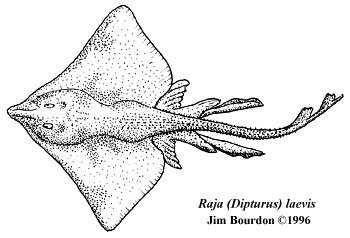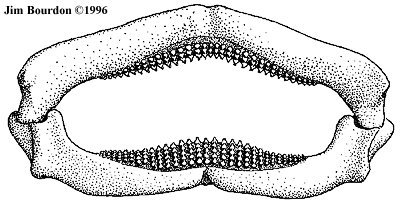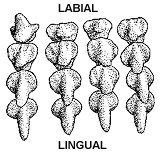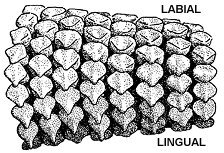| |

Compared with guitarfishes, the skates have more broadly expanded discs, less stout tails and reduced or absent caudal fins. The pelvic fins are expanded (may be divided) and the rostrum generally longer. The skates can be further characterized by their numerous thorns and the lack of a caudal stinging spine. The teeth are small and arranged in numerous files.
In today's oceans, some 230 species are known to exist - most with relatively similar tooth morphologies. Scientists working with these fish continue their attempts to assign and reassign species to a genus or subgenus. The genus Raja encompasses well over a third of the known skates and has been divided into nine subgenera. One of these, R. (Rajella) STEHMANN, 1970, has been further refined into two morphotypes to further segregate its 13 species.
When Bigelow & Schroeder (1948) inventoried these fish, they listed 29 species for the western North Atlantic, but only ten of these would be likely candidates for Lee Creek waters. The species that have the best shot at being represented are: Breviraja plutonia & spinosa, Dactylobatus armatus, Raja (Amblyraja) radiata, R. (Dipturus) laevis, R. (Leucoraja) erinacea, garmani & ocellata, and R. eglanteria.

Skate Teeth
Depending on species (and individuals), the number of files and rows can vary greatly. Illustrated (Fig. 4) is a portion of USNM #110,960's lower jaw. Identified as Raja (Leucoraja) ocellata [female], it has 73 upper files and 72 lower - over 2,000 tightly packed, small teeth (ranging from 0.4 to 1.3 mm in width). A simpler dentition is that of R. (Dipturus) laevis, refer to figure 3 of USNM #110,962 [male]. Each jaw has just over thirty files which are widely separated. The elongated male cusp is clearly evident.
Ontogeny is another variability which has gone to extremes in skates. Younger specimens may have roots that display little or no nutrient groove, while larger specimens show fully developed grooves. Although crowns may remain somewhat similar, the roots can vary substantially from distal to mesial location. Depending on species the roots may be wider or narrower than the crown, symmetrical or asymmetrical, parallel or splayed, have a well formed nutrient groove or virtually lack one.
Raja (Dipturus) laevis -- MITCHILL, 1817
Barndoor skate
This common skate of the western North Atlantic, from North Carolina to New Foundland, is a likely candidate for representation in the Lee Creek fauna, at least the subgenus Dipturus. Referred to as the Barndoor skate, it can be found near shore in warm waters or down to the cooler waters of over 1000 feet. Recovered F-type tooth specimens have corresponded well with descriptions of these teeth and the crowns compared favorably with those from the illustrated dentition of a R. laevis male (figures 2 & 3). In addition to external similarities, certain damaged teeth were studied in cross section and one corresponded with histological descriptions provided by Herman et al (1995). For additional information on this species and its sensitivity to fishing pressure see Barndoor Skate by Jill M. Casey and Ransom A. Myers.
 |
Fig. 2 R. (Diptureus) laevis
USNM #110,962, male dentition 19.7 cm in width |
 |
 |
Fig. 3 R. laevis
USNM #110,962, male
Lower LH files; symph, 1-3.
Illustrated width = 14.9 mm. |
Fig. 4 R. (Leucoraja) ocellata
USNM #110,960, female
Lwr RH files: 3-10
Illustrated width = 10.8 mm |
|